This document covers the following topics:
An object type-specific content editor appears when you open an existing documentation object, or when you add a new documentation object.
The object type-specific content editors have different tabs with different types of edit controls.
Note:
With Predict 4.6.1 Fix 1 the metadata structures are
changed to be more user friendly. Therefore, it may appear that tabs and edit
controls within tabs are differing from those displayed in this
documentation.
Two types of tabs are available:
Common tabs that are always the same for all object types are Overview and Extended Description. See Global Attributes in the reference documentation Predefined Object Types in Predict.
Tabs that are only shown for this type of object. See the object type-specific descriptions in the reference documentation Predefined Object Types in Predict.
The tabs are shown at the bottom of the content editor. When more tabs are available than can be shown on the screen, a number at the bottom right indicates that there are more tabs. When you select this number, you can display a tab by choosing its name from a list.
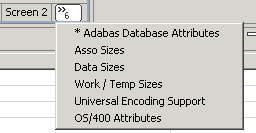
Several tabs require that you specify mandatory information. Such a tab shows an asterisk (*) next to the tab name.
Some tabs provide simple edit controls such as text boxes, check boxes or drop-down list boxes.
For the description of check boxes, the reference documentation Predefined Object Types in Predict uses the abbreviations Y (yes) and N (no). Y means that the check box is selected, and N means that the check box is not selected.
Some tabs such as the Overview tab provide a simple text editor such as the Abstract section. Edit commands like and are available in a context menu. Example:
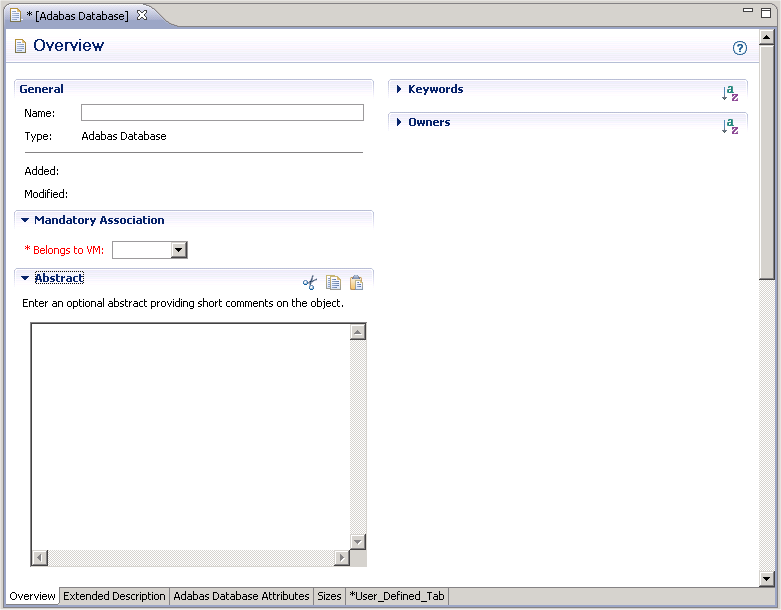
The following tabs provide a text editor:
Extended Description,
Processing Rule (of a verification),
Check Expression (for files of type DB2 Table),
Subquery (for files of type DB2 View) and
Field Expression (for a DB2 View Field).
Using the commands from the common menu, you can , , , , and text. In addition, you can undo and redo your last change and make a operation.
The above commands are available using the corresponding Eclipse keyboard shortcuts.
Some of these commands are also available when you invoke the context menu in the editor.
When using the editor the following functions are available:
The function in the Eclipse Preferences can be switched on/off in the editor.
 To display the Text Editors preferences from within the text
editor
To display the Text Editors preferences from within the text
editor
On any column in the editor, invoke the context menu and click on the option.
The Text Editors preferences menu is displayed.
Activate/deactivate the option.
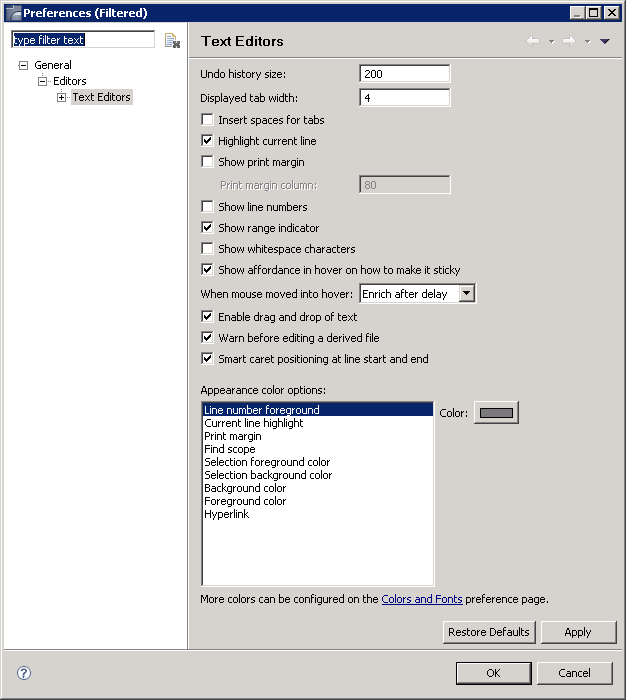
Click .
The text editor now displays/hides line numbers.
The function is available via the Eclipse keyboard shortcut Ctrl+L. The following dialog is displayed:

The Eclipse Status Line shows whether the object is ("Writable" or "Read-Only"), the editor´s insert mode ("Smart Insert" or "Overwrite") and the current cursor position (following the pattern "line : column").
![]()
A double click on the status field insert mode toggles this mode.
A double click on the status field cursor position opens the above dialog.
Some tabs provide tables to which you can add new information. A table may contain one or more resizable columns. Example:
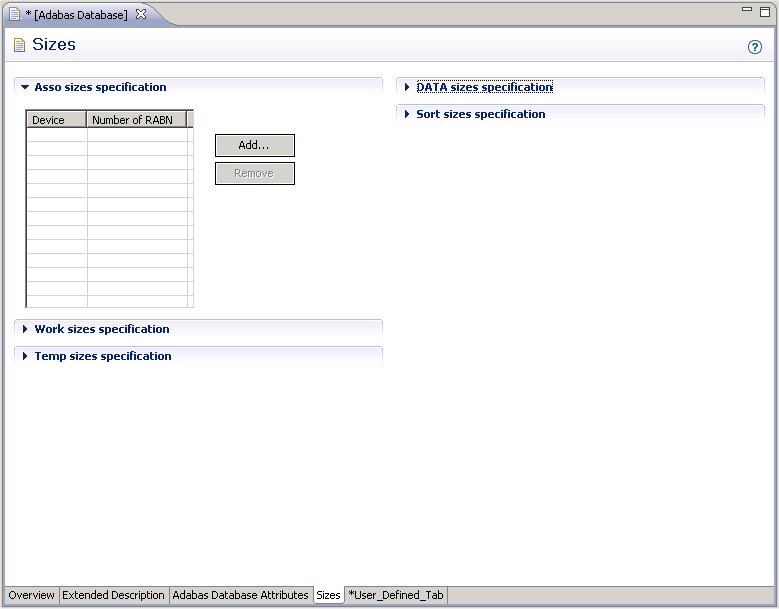
The following command buttons are provided with a table:
| Command Button | Description |
|---|---|
| Creates a new row containing several cells in which you can enter information. | |
| Removes the selected row. |
The following functions are provided in the context menu of a table:
| Command Button | Description |
|---|---|
| Creates a new row containing several cells in which you can enter information. | |
| Deletes the selected row. |
To modify existing information in a cell of the table, simply overwrite it. You can either enter information directly in a cell or select it from a drop-down list box.
To save your changes in an object type-specific content editor, you simply use the Eclipse save functionality.
Notes:
You can manually add documentation objects for all predefined and user-defined objects types in Predict. You have to specify all information yourself, including the implementation pointer. This function is helpful, if documentation is to take place before implementation. Information on the implementation pointer can be found under Opening the Description for a Natural Object.
 To add a new documentation object
To add a new documentation object
Select the object type for which you want to add a new object.
Invoke the context menu and choose .
In some cases, you have to select a type (for example, a database type) in a dialog box. The resulting content editor then shows object-specific information.
Specify all required information as described in the reference documentation Predefined Object Types in Predict. See also Object Type-Specific Content Editors.
When a documentation object is modified, renamed or deleted, it is automatically locked to prevent concurrent updates.
When working with associations and links, the following applies:
When the command is used, the parent object is locked. See also: Linking and Unlinking Associations.
When the command is used, both the parent and child object are locked. See also: Modifying the Attributes of a Link.
Caution:
Currently, locking of documentation objects is only possible on
the client side when using Predict Description and Generation. When performing actions on
documentation objects in Predict on the server side, the locking mechanism is
ignored. This can result in inconsistent data.
When a system interruption has occurred, you can manually unlock locked documentation objects.
Important:
You should only unlock a documentation object when you are
sure that this object is currently not being edited by another
user.
 To unlock a documentation object
To unlock a documentation object
Select the documentation object that you want to unlock.
Invoke the context menu and choose Unlock Object.
When you open a documentation object, it is possible to modify it (edit mode). There is one exception: when the documentation object is currently locked, it is only possible to view the information, it is not possible to modify the documentation object (read-only mode).
 To open a documentation object
To open a documentation object
Select the documentation object.
Invoke the context menu and choose either or .
Or:
Double-click the documentation object.
An object type-specific content editor appears. See also Object Type-Specific Content Editors.
You can change the object ID with the command. The new object ID must not already exist in the dictionary.
 To rename a documentation object
To rename a documentation object
Select the documentation object that you want to rename.
Invoke the context menu and choose .
A dialog box appears prompting for a new name.
Specify another name and choose the button.
You can purge documentation objects using the command.
For further information on the purge process, see the object type-specific descriptions in the reference documentation Predefined Object Types in Predict.
 To purge a documentation object
To purge a documentation object
Select the documentation object that you want to purge.
Invoke the context menu and choose .
A dialog box appears asking whether you really want to delete the object.
To confirm the deletion for the current object, choose the button.
The information shown in an object-type specific window (which can be invoked with the or command) can also be shown as a report in simple text format. It is possible to print and save this report.
 To print and save a report
To print and save a report
Select the documentation object.
Invoke the context menu and choose .
A window such as the following appears.
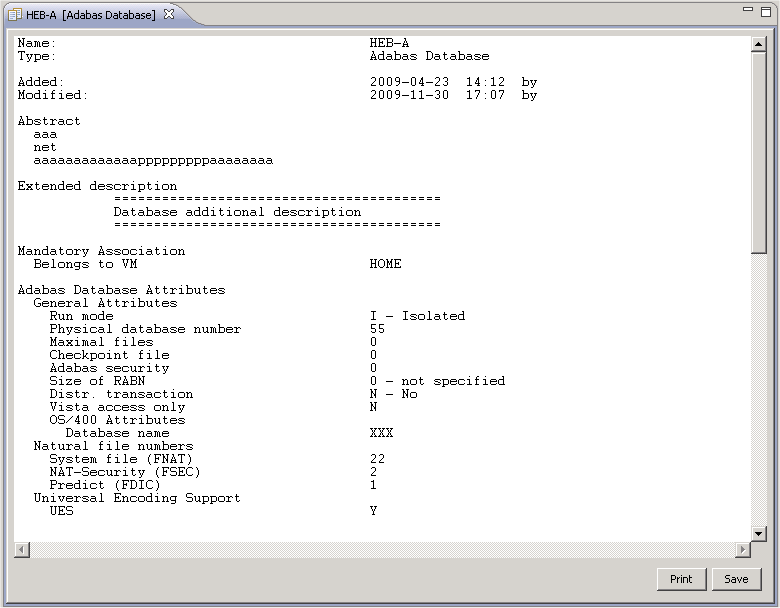
Choose the desired command button:
| Command Button | Description |
|---|---|
| The Print Setup dialog box appears. Specify all required information (for example, a different printer or text orientation) and choose the button. | |
| The Save Report dialog box appears. Select the folder in which you want to store the report, specify a report name and choose the button. |
To close the window in which the report is shown, choose the button.